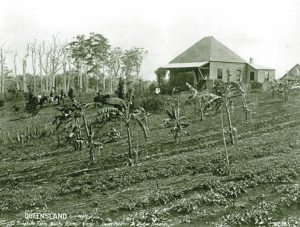North Maleny Pioneers
A wonderful history told by Mr. William Simpson, about the first visitors, and the ones who stayed, all while being helped by the local Aborigines.
Transcribed from ‘The Brisbane Courier’ Thursday, 25th April 1923

William Simpson’s Farm, North Maleny
PIONEERS OF MALENY. THE FIRST WHITE WOMAN. In common with other centres in Queensland, Maleny has instituted a search for the oldest residents of the district. The Simpson family appear to be entitled to this honour. At all events, Mrs. W. Simpson, now of Goonurga, Grange Hill, Brunswick Street, Brisbane, can claim to be the first white woman who visited the locality, having settled there in 1881 with her husband who had taken up the selection which he still holds two years before. Mr. Simpson the other day related some of his experiences in the Coochin Creek and Maleny districts, and, like those of other pioneers, these included many hardships of which present-day settlers on the land have no conception. Mr. Willliam Simpson, with his brother, Mr.John Simpson (now of Coochin Creek and Beerwah sawmills), and Mr. James Mawhinney (now living near Beerwah railway station) first travelled up the North Coast country in 1873 or 1874, when Mr. John Simpson’s contracts for the supply of bridge timbers, fencing material, and stone ballast for the continuation of the Western railway from Ipswich to Brisbane was nearly completed.
The three set out on three good horses from Redbank, via Brisbane, Caboolture, Glasshouse Mountains (W. Grigor’s), and Cobb’s Camp (now Woombye), the half-way stopping place for Cobb and Co.’s line of mail and passenger coaches, where the coaches used to meet and stay all night. One coach came from Brisbane and the other from Gympie, each returning next day. Their route lay thence to Maroochy, where they met friends (Mr. Angus Campbell and Mrs. James Low, his sister) from Moggill. They soon got blacks to pilot the party through the bush-there were no roads then-to Noosa sawmill.
From there they went on to Gympie, and returned by the Gympie-road through the scrubs, looking for timber.” We came back,” said Mr. Simpson, “as far as Commissioner’s Flat, near Durundur, where my brother arranged for some cedar timber with a Major Lewis, who owned a small cattle station, The Cove. We then returned to Redbank for our teams and men. My brother had a strong horse team, and I had a bullock team. We soon got back and started to haul cedar logs to Caboolture, and my brother and James Mawhinney did some pit-sawing of cedar. “It was a very wet season, indeed, and sometimes we had to take packhorses to Caboolture and pack rations out to The Cove, where we were camped getting cedar. I have seen our pack- horses getting bogged in the bush with only 30lb. of flour or a bag of sugar on their backs and often we had to swim them over some of the smaller gullies or creeks. I have pulled Cobb and Co.’s mail coach out with my bullocks, when it was bogged on the Gympie-road, the late Mr. Barnes being the coachdriver then.
“In 1875 we shifted our camp to the 4000-acre ridges of Durundur, near what is now Peachester, and there started to get cedar out on the southern slopes of the Blackall Range. We intended selecting it. While there Mr. John Simpson (my brother) and his family came to live there, being the first pioneer white family, including a woman, in that district. Messrs. McConnel and Wood, the lessees of Durundur, came to hear of our intention to select and gave us notice to quit. My brother then selected a grass pocket nearer the Blackall Range, named Bunya Aris, near where Mr. Jenner and others now have fruit and dairy farms near Crohmanhurst. There we were engaged in building and timber-getting for some time, felling timber up to where Mr. Ebb. Smith’s selection and home are near Maleny and drawing it to Coochin Creek rafting ground. “One Sunday, when Bill Hayes and I were out exploring the scrub, we got out through what is known as Dunlop’s Pocket to Dunlop’s Pinch – the “present big “pinch” on the Landsborough Maleny road -and to our surprise found a cottage there, where the late Mrs. Dunlop and her family, Francis, William, and Jane (now Mrs Trail), were living on Mr. W. Pettigrew’s selection.
The Dunlop family are still living in Maleny. Later we selected at Coochin Creek, and went there to live. My brother John still resides there on one of the selections, and his large family also reside in that district. Mr. James Mawhinney and his family live near Beerwah railway station. “I married in February, 1879, at Loganholme, near Beenleigh, my wife being the eldest daughter of the late Mr. and Mrs. Archibald Auld, of Logan Braes, Cedar Grove, Upper Logan. We lived at Coochin Creek, for some time, during which my brother and I, with our men and a few blacks, returned to the Blackall Range felling cedar about and on what is now known as Walker’s selection, passing on in front of where the late Mr. lsaac Burgess, of Mellum Creek, had Joe Eyles, Francis Dunlop (now of Maleny), Tom Maddock (now of Mooloolah), and other men felling cedar on the place now known as Burgess, Campbell, and J. Eyles’s selections; their logs being sent principally to James Campbell and Sons, Creek Street Brisbane.
We went past them and felled cedar on our present farm out on unknown country as far as Boorroon Pocket. The late Mr. W. Grigor, of Glasshouse Mountains, and his son, John Grigor (now of Maleny), were felling timber with some blacks opposite us, where Mr. Thynne’s dairy farm now is. This is where the different tribes of blacks used to meet to fight. We camped there for some time felling cedar. Afterwards I selected our present dairy farm at Maleny. “Just after we got back to Coochin Creek Mr. Jos. McCarthy came up with his men and bullock teams, extending our timber roads on up to the Blackall Range, and selecting the dairy farm where Mrs. McCarthy and her family still reside. He started pit-sawing cedar and drawing cedar logs with us to Coochin Creek rafting ground. As soon as I could after selecting in 1879 I took my teams up the Blackall Range to the selection, arriving late on December 24, 1879, the bullock drivers being Alf. Wells (now of Palmwoods), S. J. Burgess (of Bald Knob, Landsborough), and myself. We could not get the bullocks through the scrubs that night, as we had only a small track brushed – that is, the small scrub vines cut – no road, and had to stop until next morning.
On December 25 we mustered up early and just put the bullocks through the scrub into Boorroon Pocket on the grass, and left them, and had to ride to Mellum Creek (now Landsborough), where the late Mr. Isaac Burgess owned a hotel, for our first meal – a late Christmas dinner. “When we returned in January, 1880, we found quite a number of our bullocks bogged and dead in the swamps. That was my fault and my loss for not putting the bullocks properly into the pocket and down to the Obi Obi Creek for water, as they had had no water and little food, like ourselves, for two days. “In January, 1881, when A. Wells and I. Burgess were down with their bullock teams at my brother’s selection at Coochin Creek, getting a waggon and repairs done, mv wife packed up her furniture, and we put it on the waggon and took it up the Blackall Range to our present dairy farm at Maleny. It being so wet and so late, the teams could not get to the camp, and had to leave the waggons in the scrub about a mile from the camp with the furniture and fowls for two weeks.
There were no houses in those days only small huts, 10ft. by 12ft., with 4ft. walls of palm, with a tarpaulin spread over them. Mrs. Simpson baked dampers for us, She rode up the range on horseback and carried her baby boy, Willie, 11 months old, in the wet, they being the first pioneer white woman and child in the Maleny Scrub district. That was 42 years ago. Joe Eyles had only a small piece of clearing up there then. Mrs. Simpson has many times since then stayed for weeks alone with the child on the selection in the scrub, as I took the teams back and was timber-getting at Coochin and Mellum creeks for James Campbell and Sons, their sawmill being at Campbellville, on Mellum Creek. My wife’s only neighbours and guardians were the blacks, King Sambo and Queen Beauty, “Captain” Piper (who killed the Government Botanist at Meridian Plains, Mooloolah), and five gins. They were good friends and watched over Mrs. Simpson well, bringing up the cows to be milked morning and evening, and sometimes carrying rations up from Landsborough. Queen Beauty was a faithful old gin, but a regular termagant. I have known her to attack King Sambo furiously with anything that was handy on very trivial provocation. These were some of the blacks who piloted my brother John and myself through the dense Maleny scrub. Captain Piper left us and went to Cobb’s Camp (now Woombye), where he was caught by Tom Maddock for the murder of the botanist. Alter he was released from prison he came back to us.
My son Willie, the baby of those days, now has a butchering business at Montville. “Later there came a Mr. and Mrs. Otto to John Campbell’s selection, Balmoral, where David Burton was engaged by Messrs. Campbell, growing sugar cane for bullock feed. Mr. J. Burgess, the pioneer farmer, also used sugar cane for feed, as there was no grass, nothing but scrub everywhere. Burton, while drawing cedar in the scrub, planted a number of fruit trees, which grew well. A Max Wandrey was on Campbell’s other selection, Ellerslie, and Joe Eyles had a selection, adjoining Campbell’s, where he grew sugar cane to serve as feed for his bullocks when out there drawing timber. These were the first clearings in the Maleny district. “About two years later Mrs. McCarthy and Mrs. Samson Brown and their families came up, the McCarthy’s going on to their present dairy farm, where Mr. McCarthy had some clearing, and was engaged in cedar getting.
The Browns went to Mellum Creek, and later to Messrs. J. and L. Greave’s selection for a while, afterwards removing to their own selection, now Mr. Webster’s. “Maleny was now beginning to get some settlement about it, and it has been improving and going ahead ever since. We have seen it progress from dense scrub to the present thriving township, with a motor car service to the railway. If we had listened to and helped Mr. John Campbell years ago, Maleny would have been served by a railway in place of motors, and it would not have cost as much as the present road is going to cost the land owners.”

 ©2016 Montville History Group. All rights reserved.
©2016 Montville History Group. All rights reserved.